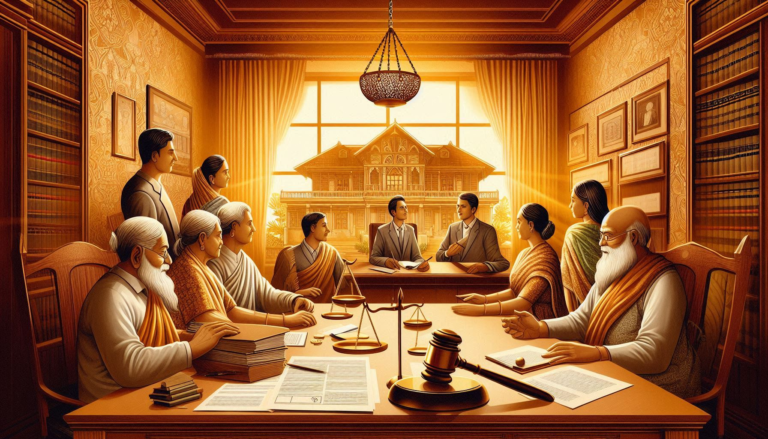
Abstract
Property law is a crucial aspect of legal systems, but there is a lack of understanding of the relationship between jurisprudence and different categories of property law, including that about intellectual, personal, and real property. The study delves into the intricate realm of property law in India, exploring its philosophical underpinnings, legal frameworks, and societal implications. Through an analysis of jurisprudential perspectives, including those of Austin, Salmond, and Bentham, the research elucidates the multifaceted nature of property rights, encompassing tangible and intangible assets and spanning diverse legal theories. The paper examines the jurisprudential principles of legal positivism, natural law, and legal realism that influence property law in India. It looks at how they affect several kinds of property, including properties, personal, and intellectual property. The study focuses on multiple types of property theories, such as natural law, labour theory, historical theory, and psychology theory, to comprehend the varied viewpoints that influence property rights and ownership. To shed light on the legal ramifications and distinctions between various property types such as real and movable, and immovable, personal corporeal and incorporeal, the research also looks at these distinctions. The research demonstrates how property rights in India have changed over time, moving from being regarded as basic rights to common legal rights. It adds to a more sophisticated comprehension of Indian property law.
Introduction
Property disputes are settled and property transactions are arranged according to property law, principles, laws, and regulations. Because it addresses the connections between and among members of a community with regard to “things,” property law differs from other forms of law. In this case, the items may be intangible like bonds, bank account, and stocks or they could be tangible like factories, land, or diamond ring.
Therefore, property law deals with the ways in which wealth is used, distributed, and transferred. As such, it is a reflection of the society’s economy in which it exists. Property law additionally represents the family structure of the culture it is located in, as it deals with the transfer and control of money between spouses and between generations. Finally, property law reflects the political environment of the society in which it is present, as it addresses such basic concerns as the economy and the family unit.
This article outlines the introduction to property law, its definition and meaning, history, examples, and other details. Students or professionals engaged in the field of law may find this article quite useful for them as it covers wide areas of property law that may help them in their educational or professional career.1
History of Property Law in India
One of the core components of India’s socioeconomic structure is property. The legal system lacked consistency and was for a long time predicated on morality and conscience. Such approach resulted in several crimes, even in the case of property. During the Mughal era, property law advanced significantly.
It incorporated the Zamindari System with the Mughals’ system of land tenure. Under this arrangement, zamindars, who in turn granted farmers access to the land for cultivation and gathered taxes from them, were granted a lease on property controlled by a monarch. In the 18th century, the British East India Company began to acquire property in India.
Peasants staged many uprisings due to the company’s land acquisition tactics, which were perceived as exploitative and arbitrary. The Indian National Congress promoted land reforms in India in 1885. The “Independent India” government passed a number of laws pertaining to land reforms. With the introduction of the Zamindari Abolition Act in 1956, the Zamindar system was eventually put an end and the land’s ownership rights were offered to the farmers.
The Supreme Court ruled in Vineeta Sharma v. Rakesh Sharma (2020) 9 SCC 1 that a daughter or woman had an equal claim to her family property. Property law has evolved significantly in India since independence. Owing to evolving trends, the government has enacted a number of new laws and rules.2

Property rights and rights to people
Property rights are rights over things enforceable against all other persons. By contrast, contractual rights are rights enforceable against particular persons. Property rights may, however, arise from a contract; the two systems of rights overlap. In relation to the sale of land, for example, two sets of legal relationships exist alongside one another: the contractual right to sue for damages, and the property right exercisable over the land. More minor property rights may be created by contract, as in the case of easements, covenants, and equitable servitudes.
A separate distinction is evident where the rights granted are insufficiently substantial to confer on the nonowner a definable interest or right in the thing. The clearest example of these rights is the license. In general, even if licenses are created by a binding contract, they do not give rise to property interests.3
Property rights and personal rights
Property rights are also distinguished from personal rights. Practically all contemporary societies acknowledge this basic ontological and ethical distinction. In the past, groups lacking political power have often been disqualified from the benefits of property. In an extreme form, this has meant that people have become “objects” of property—legally “things” or chattels (see slavery.) More commonly, marginalized groups have been denied legal rights to own property. These include Jews in England and married women in Western societies until the late 19th century.
The dividing line between personal rights and property rights is not always easy to draw. For instance, is one’s reputation property that can be commercially exploited by affording property rights to it? The question of the proprietary character of personal rights is particularly relevant in the case of rights over human tissue, organs and other body parts.
In the United States, a “quasi-property” interest has been explicitly declared in the dead body. Also in the United States, it has been recognised that people have an alienable proprietary “right of publicity” over their “persona”. The patent/patenting of biotechnological processes and products based on human genetic material may be characterised as creating property in human life.
A particularly difficult question is whether people have rights to intellectual property developed by others from their body parts. In the pioneering case on this issue, the Supreme Court of California held in Moore v. Regents of the University of California (1990) that individuals do not have such a property right.4
Interpretation of “property”
Property is broadly classified into the following categories:
- Immovable Property (excluding standing timber, growing crops, and grass)
- Movable Property (such as watches, timbers)
The Interpretation of the Act, says “Immovable property does not include standing timber, growing crops or grass”. Section 3(26) of the General Clauses Act, 1897 states that ” immovable property” shall include land, benefits to arise out of the land, and things attached to the earth, or permanently fastened to anything attached to the earth. A similar definition is provided by the Registration Act, 1908 under section 2(6):
“immovable property” includes land, buildings, hereditary allowances, rights to ways, lights, ferries, fisheries or any other benefit to arise out of the land, and things attached to the earth or permanently fastened to anything which is attached to the earth, but not standing timber, growing crops nor grass.
A transfer of property passes forthwith to the transferee all the interest which the transferor is then capable of passing in the property unless a different intention is expressed or implied.
According to Section 43 of the Transfer of Property Act 1882, in case a person either fraudulently or erroneously represents that he is authorized to transfer certain immovable property and does some acts to transfer such property for consideration, then such a transfer will continue to operate in future. It will operate on any interest which the transferor may acquire in such property.
This will be at the option of the transferee and can be done during the time during which the contract of transfer exists. As per this rule, the rights of the bona fide transferee, who has no notice of the earlier transfer or of the option, are protected. This rule embodies a rule of estoppel i.e. a person who makes a representation cannot later on go against it.

Every person, who is competent to contract, is competent to transfer property, which can be transferred in whole or in part. He should be entitled to the transferable property, or authorized to dispose of transferable property which is not his own. The right may be either absolute or conditional, and the property may be movable or immovable, present or future. Such a transfer can be made orally unless a transfer in writing is specifically required under any law.
Even when a person is mentally competent, but physically unable to sign any contract, the property lawyer hired by him, can do that with the help of a power of attorney.
According to Section 6 of the Transfer of Property Act, the property of any kind may be transferred. The person insisting non-transferability must prove the existence of some law or custom which restricts the right of transfer. Unless there is some legal restriction preventing the transfer, the owner of the property may transfer it. However, in some cases, there may be a transfer of property by an unauthorized person who subsequently acquires an interest in such property.
In case the property is transferred subject to the condition which absolutely restrains the transferee from parting with or disposing of his interest in the property, the condition is void. The only exception is in the case of a lease where the condition is for the benefit of the lessor or those claiming under him. Generally, only the person having interest in the property is authorized to transfer his interest in the property and can pass on the proper title to any other person. The rights of the transferees will not be adversely affected, provided: they acted in good faith; the property was acquired for a consideration, and the transferees had acted without notice of the defect in the title of the transferor.
These conditions must be satisfied:
There must be a representation by the transferor that he has authority to transfer the immovable property. The representation shouldn’t be either fraudulent or erroneous. The transferee must act on the representation in good faith. The transfer should be done for a consideration. The transferor should subsequently acquire some interest in the property he had agreed to transfer. The transferee may have the option to acquire the interest which the transferor subsequently acquires.5
Conclusion
Property laws in India provide a framework of responsibilities and benefits for property owners in an effort to balance the rights of individual property owners with the broader interests of society. The implementation of just land acquisition procedures, robust and transparent land records systems, and effective tenancy restrictions can lead to a more equitable and efficient property ecosystem. A flexible and adaptive framework would be necessary to promote social justice, sustainable development, and harmony in the context of property ownership and transactions given how swiftly India is developing.
References
- Lloyd Law College. (2024, August 5). Property Law: Definition, History, Key Examples & Important Facts. Retrieved from https://www.lloydlawcollege.edu.in/blog/property-law definition-history-examples-facts.html
- Vineeta Sharma v. Rakesh Sharma, (2020) 9 SCC 1- The Supreme Court held that daughters have equal coparcenary rights in Hindu Undivided Family property by birth, under the Hindu Succession (Amendment) Act, 2005.
- Kevin Gray and Susan Francis Gray, Elements of Land Law (5th edn., OUP 2009) ch 1.
- Moore v. Regents of the University of California, 793 P.2d 479 (Cal. 1990), where the California Supreme Court held that a patient did not retain a property interest in cells taken from his body and used for commercial research.
- Sumeet Malik. Property Law Manual (Hard Bound) (2014 ed.). Eastern Book Company. Pp. 1-968. ISBN 9789351451150
Footnotes
- Lloyd Law College. (2024, August 5). Property Law: Definition, History, Key Examples & Important Facts. ↩︎
- Vineeta Sharma v. Rakesh Sharma, (2020) 9 SCC 1- The Supreme Court held that daughters have equal
coparcenary rights in Hindu Undivided Family property by birth, under the Hindu Succession (Amendment)
Act, 2005. ↩︎ - Kevin Gray and Susan Francis Gray, Elements of Land Law (5th edn., OUP 2009) ch 1. ↩︎
- Moore v. Regents of the University of California, 793 P.2d 479 (Cal. 1990), where the California Supreme
Court held that a patient did not retain a property interest in cells taken from his body and used for commercial research. ↩︎ - Sumeet Malik. Property Law Manual (Hard Bound) (2014 ed.). Eastern Book Company. Pp. 1-968. ISBN ↩︎




